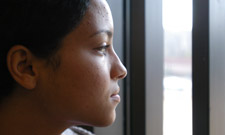In addition to the feature-length documentary Who Cares About Kelsey?, we have created eleven short documentaries that illustrate a wide range of educational issues and evidence-based practices, including Augmentative and Alternative Communication, Positive Behavioral Interventions and Supports, Breaking the School-to-Prison Pipeline, Universal Design for Learning, Cultural Responsiveness and more. Ten of the videos can be viewed at the links below:
Tariq Zubhuza
Tariq Zubhuza, an inmate at the NH State Prison for Men, shares events that led him into the system. “If you’re 11 years old and you’re drunk, it’s a problem,” Tariq says.
Latoya Fletcher
Latoya Fletcher, an inmate at the NH State Prison for Women, discusses the life events and school circumstances that led her into the juvenile justice system, and what type of interventions might have put her on a different path. “My mom was left out of the loop,” Latoya says.
Education Revolution at Somersworth High School
A closer look at the transformation of Somersworth High School, site of Who Cares about Kelsey?, through schoolwide Positive Behavioral Interventions and Supports. This mini-film highlights student leadership and data-driven decision making.
Marcel
Marcel, 8, struggles with mental health challenges that have led to fits of violence. His Missouri school attempts to include Marcel in general education classrooms as the school district works to address racial disparities in discipline and education. Marcel highlights the importance of family engagement and cultural responsiveness.
Thasya
Thasya Lumingkewas, 8, thrives at Maple Wood Elementary School in Somersworth, NH. The school has implemented Response to Intervention and Positive Behavioral Interventions and Supports. This mini-film highlights the power of differentiated instruction and augmentative and alternative communication.
Daniel Frost
Daniel Frost, who is incarcerated at the Sununu Youth Services Center, talks about how he became involved in the juvenile justice system, and what type of interventions might have put him on a different path. “They picked on me a lot. I have Tourette’s,” Daniel says.
Joe Masiello
Joe Masiello, who is incarcerated at the Sununu Youth Services Center, talks about how he became involved in the juvenile justice system, and what type of interventions might have put him on a different path. “At five or six, I was sexually abused and diagnosed with manic bipolar,” Joe says.
Nicole Kasinskas
Nicole Kasinskas, an inmate at the NH State Prison for Women, discusses the life events and circumstances that led her into the juvenile justice system, and what type of interventions might have put her on a different path. “I had no hopes and dreams,” Nicole says.
Axel
Axel is a fifth grader with autism who is non-verbal and exhibits significant behavioral challenges. Through effective communication supports, Axel was able to learn fifth grade general education curriculum in a general education classroom. Support for this film was provided by the National Center and State Collaborative.
Restraint and Seclusion: Hear Our Stories
Six individuals describe their experiences with restraint and seclusion in schools, and the devastating physical and emotional injuries they suffered as a result. Visit StopHurtingKids.com to learn more about the campaign and to download the free discussion guide.
Tariq Zubhuza from Dan Habib on Vimeo.
Julio Panameno from Dan Habib on Vimeo.
MARCEL: OPEN CAPTION from Dan Habib on Vimeo.
THASYA hi-res OPEN CAPTION from Dan Habib on Vimeo.










